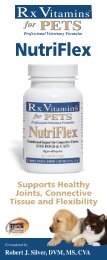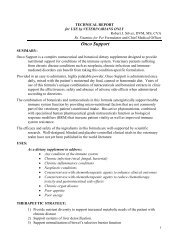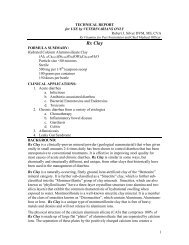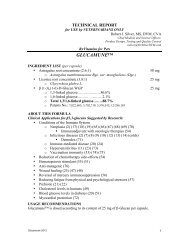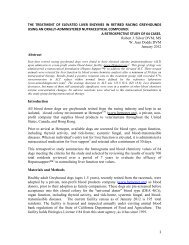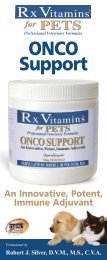NutriGest - R X Vitamins
NutriGest - R X Vitamins
NutriGest - R X Vitamins
Create successful ePaper yourself
Turn your PDF publications into a flip-book with our unique Google optimized e-Paper software.
USES:<br />
TECHNICAL REPORT<br />
for USE by VETERINARIANS ONLY<br />
Robert J. Silver DVM, MS, CVA<br />
Rx <strong>Vitamins</strong> for Pets Formulator and Chief Medical Officer<br />
<strong>NutriGest</strong><br />
As a dietary supplement to aid in the treatment of:<br />
Acute and chronic diarrhea<br />
Chronic intestinal infections/Intestinal Dysbiosis<br />
Inflammatory Bowel disease(s)<br />
Chemotherapy-associated gastrointestinal side-effects<br />
With antibiotic administration to promote bowel recolonization<br />
THERAPEUTIC STRATEGY:<br />
1) Provide nutritional support for repair of damaged intestinal mucosa<br />
2) Provide substantial counts of colony forming units of beneficial bacteria to reinoculate<br />
bowel microflora<br />
3) Support normal function of bowel<br />
4) Gently eliminate pathogenic micro-organisms from bowel microfloral ecology<br />
5) Provide nutritional co-factors to improve digestive function<br />
6) Provide botanical and nutraceutical support to reduce heightened<br />
inflammatory response in the bowel<br />
INGREDIENT LIST (2 capsules or ½ teaspoon of powder provides):<br />
1. Probiotic Cultures: (L-Acidophilus (85%); L-Thermophilus (1.7%); L-Plantarum (1.7%)<br />
Bifidobacterium Bifidum (5%); Bifidobacterium Longum (5%); B-Coagulans<br />
(1.7%)……………………………………………………500 million viable cells<br />
2. L- Glutamine (free form amino acid)..........................................……...200 mg.<br />
3. Cats Claw (Uncaria tomentosa) (standardized to 3% oxindole<br />
alkaloids)...........................................…………………………150 mg.<br />
4. N-acetyl D glucosamine..........................................................………....150 mg.<br />
5. Calcium pantothenate…..........................................................…………100 mg.<br />
6. Ginger root extract(standardized Zingiber officinale supplying 4% volatile<br />
oils)....................................................…………….....…………50 mg.<br />
7. Fructooligosaccharide..............................................................………….50 mg.<br />
8. Oregon Grape Root (Mahonia repens)...........................................…......50 mg.<br />
9. Garlic (Allium sativum) (standardized to 1% total allicin potential)...…..25 mg.<br />
10. Psyllium Seed (Plantago ovata)....................................…...............….....25 mg.<br />
11. Aloe Extract (emoden free)........................................................…….......25 mg.<br />
12. DGL (deglycerrhized licorice)......................................................……....25 mg.<br />
13. Folic Acid.............................................................................…………...50 mcg.<br />
14. Vitamin A (retinol)..........................………………….............…………100 IU.<br />
1
INGREDIENT RATIONALE:<br />
Probiotic cultures: Intestinal microflora play a significant role in the maintenance<br />
and health of the gastrointestinal tract (Shahani, 1980). Studies<br />
demonstrate that certain strains of intestinal microflora beneficially<br />
influence the host immune response. (Perdigon, 1988) Probiotic cultures<br />
are an exogenous source of these beneficial bacteria which can recolonize<br />
the bowel and improve intestinal microfloral ecology. Other studies have<br />
demonstrated that beneficial bacteria also exert an “antibiotic” effect upon<br />
pathogenic intestinal microflora such as Pseudomonas spp., E. coli, and<br />
the agents causing “traveler’s diarrhea” in humans. (Price, 1970)<br />
(Clements, 1981) (Warram, 1978)<br />
Lactobacillus acidophilus has been shown to inhibit the following bacteria<br />
(Murray, 1996):<br />
Bacillus subtilis<br />
B. cereus<br />
B. stearothermophilus Candida albicans<br />
Escherichia coli<br />
Clostridum perfringens<br />
L. bulgaricus Klebsiella pneumonia<br />
Lactobacillus helveticus<br />
L. fermenti<br />
L. leichmannii L. lactis<br />
Proteus vulgaris<br />
L. plantarum<br />
Pseudomonas aeruginosa P. fluorescens<br />
Salmonella typhosa<br />
S. schottmuelleri<br />
Shigella dysenteriae<br />
S. paradysenteriae<br />
Sarcina lutea<br />
Serratia marcescens<br />
Stapholococcus aureus<br />
Streptococcus faecalis<br />
S. lactis Vibrio comma<br />
Reinoculation of the bowel with active cultures of beneficial intestinal<br />
microflora will help to restore healthy digestion if administered both<br />
during and after a course of antibiotic therapy. Oral administration of l.<br />
acidophilus concurrent with antibiotic therapy has been demonstrated to<br />
help maintain normal levels of beneficial intestinal bacteria. (Zoppi, 1982)<br />
An L. acidophilus strain fed to experimental animals helped to reduce the<br />
development of antibiotic resistant strains of pathogenic bacteria. (Gotz,<br />
1979)<br />
With a long history of usage as a dietary supplement for both humans and<br />
livestock, probiotics have been observed and reported to provide health<br />
benefits for cancer victims, and other patients who have immune systems<br />
weakened by viruses, medications or environmental toxins.<br />
l-Glutamine<br />
This free form amino acid has been used with a high degree of success in<br />
human medicine in the treatment of severe trauma and burns, drug and<br />
2
alcohol withdrawal, and restoring intestinal mucosal integrity. Glutamine<br />
has been found to promote intercellular hydration, which in turn triggers<br />
anabolic (tissue building-healing and repairing) activity. (Pasquale, 1998).<br />
Glutamine is known to benefit a number of tissues, including: GI mucosal<br />
cells, hepatocytes, monocytes (macrophage), T and B lymphocytes,<br />
pancreatic exocrine cells, kidney tubular cells, fibrocytes, and myocytes. L<br />
glutamine is of benefit for the anabolic metabolism in any living cell.<br />
Glutamine is considered to be a conditionally essential amino acid<br />
(Grimble, 1993). Glutamine is a conditional nutrient when its<br />
supplementation in a diet resolves symptoms associated with a dietary<br />
deficiency l glutamine. This conditional status occurs when the body’s<br />
production of glutamine is at an insufficient rate to keep up with the tissue<br />
demands.<br />
A variety of conditions and circumstances can increase the tissue demands<br />
for l glutamine. Glutamine is necessary for maintenance of the structural<br />
and functional integrity of the mucosal lining of the small intestine.<br />
(Nappert, 1999) Other studies have demonstrated that dietary<br />
supplementation with glutamine promotes the repair of damaged and<br />
“leaky” intestinal mucosal lining. (Fox, 1988) These studies, in<br />
combination with the observed clinical benefits of glutamine<br />
supplementation support the use of enteral glutamine supplementation in<br />
patients with intestinal dysbiosis as well as inflammatory bowel disease.<br />
Clinical applications of high dose glutamine therapy for chemotherapy<br />
patients has provided substantial benefits for patients undergoing<br />
potentially enterotoxic cancer therapies. Fewer gastrointestinal side<br />
effects, improved activity levels and improved appetance were noted in<br />
these patients. (Silver, 1998)<br />
Cat’s Claw (Uncaria tomentosa)<br />
This botanical compound is derived from the bark of the root of a large<br />
woody vine that grows in the South American rainforest. It contains over<br />
50 active constituents, including five oxindole alkaloids. In traditional<br />
use, Cat’s Claw is prescribed for a variety of conditions characterized by<br />
inflammation, immune system defects. or infection, such as: Skin<br />
problems, poor hair growth, rheumatism, female contraceptive, gastric<br />
ulcers, dysentery, pediatric gastroenteritis, diabetes, fevers, abscesses,<br />
chemotherapy side-effects, hemorrhage, and urinary tract infections.<br />
(Jones, 1995)<br />
In a study of the effects of Cat’s Claw published by Humberto Ruiz,<br />
Professor Emeritus of Veterinary Medicine at the University Mayor de San<br />
Marcos, Lima, Peru, studies performed on 135 dogs and 53 cats carried out<br />
over the course of four years, found Cat’s Claw to be effective in the<br />
treatment of arthritis, hip dysplasia, feline immunodeficiency viral<br />
infections, and intervertebral disc disease (Ruiz, 1995) In this study,<br />
patients were given capsules of pulverized bark, containing 250-300 mg<br />
3
per capsule. The dosage used by Ruiz was 250 mg/10 kg of body weight<br />
divided BID.<br />
Dr. Ruiz reports that cat’s claw is effective as an adjunctive therapy in the<br />
treatment of parvovirus enteritis and inflammatory conditions of the<br />
stomach, as well improve immune system function when faced with feline<br />
immuno-deficiency virus (Jones, 1995) and feline leukemia virus<br />
infections. Cat’s claw repeatedly demonstrated an ability to improve<br />
immune system function with out any sign of toxicity or adverse sideeffects.<br />
N-acetyl D-glucosamine is necessary in the manufacture of mucin, the<br />
glycoprotein that lines the intestinal tract. One study demonstrated the<br />
increased uptake of N-acetyl D glucosamine by the intestinal mucosa in<br />
patients with inflammatory bowel disease. (Burton, 1983) Some human<br />
patients with Crohn’s disease and ulcerative colitis are “slow acetylators”<br />
and are unable to convert endogenous glucosamine sulfate to N acetyl D<br />
glucosamine, and therefore must have this nutrient supplied in their diet.<br />
This glycosaminoglycan is used as substrate in the formation of the<br />
proteoglycan ground substance that holds cells together. The ground<br />
substance is weakened by the inflammatory process. Patients with chronic<br />
inflammatory conditions can benefit from the introduction of N acetyl D<br />
glucosamine or glucosamine sulfate to their diets. (Murray, 1996)<br />
Calcium pantothenate supplies both the macromineral calcium as well as the B<br />
vitamin pantothenate (B5). Vitamin B5 is utilized in the manufacture of<br />
coenzyme A (CoA) and acyl carrier protein (ACP).Both are compounds<br />
that have essential roles in the utilization of fats and carbohydrates for<br />
energy production. Pantothenate is also used in the manufacture of<br />
adrenal hormones and the production of red blood cells. As a result of its<br />
influence on adrenal hormone production, B5’s role has been<br />
acknowledged as the anti-stress vitamin. (Fry, 1976) It has been known<br />
for over 40 years that pantothenate also plays a role in improving immune<br />
system function. (Axelrod, 1955). This vitamin in this formula addresses<br />
patient stress and the loss of appetite associated with inflammatory bowel<br />
disease and the side-effects of chemotherapy.<br />
Ginger (standardized Zingiber officinale supplying 4% volatile oils) contains over<br />
300 biologically active compounds in its volatile oil fraction. These<br />
compounds have a variety of actions, including promotion of the secretion<br />
of saliva and gastric juices, stimulation of bile flow, anti-microbial<br />
activity, intestinal anti-spasmodic activity, and improving the tone of the<br />
gastrointestinal tract as well as stimulating peristalsis of the intestines.<br />
Ginger has also been used for inappetance, dyspepsia, and as a digestive<br />
aid for hypochlorhydric gastritis. In folk medicine ginger has been used to<br />
relieve flatulence, as an expectorant, and as an astringent. (Gruenwald,<br />
1998) Clinical trials have shown ginger to be an anti-emetic equivalent in<br />
activity to diphenhydramine (Mowrey, 1982) and a motility enhancer<br />
4
equivalent in activity to metoclopramide. (Yamahara, 1990). Ginger has<br />
been shown to be effective in the treatment of diarrhea. (Huang, 1990)<br />
Ginger has the unique ability to improve gastric motility at the same time<br />
as it exerts anti-spasmodic effects upon the bowel.<br />
Ginger has shown itself to have potent anti-inflammatory and painrelieving<br />
activity. A number of the volatile oil fractions in ginger are<br />
potent inhibitors of prostaglandin and leukotriene synthesis. (Kiuchi,<br />
1992) Ginger has been shown to inhibit the release of substance P from<br />
nocioceptive nerve endings. (Onogi, 1992) In this formula ginger is being<br />
used both for its anti-inflammatory activity as well as for its ability to<br />
balance digestive function for patients with inflammatory conditions of the<br />
bowel and GI problems secondary to chemotherapy.<br />
Fructooligosaccharides are short chain sugar compounds that are digested not by<br />
mammals, but by the beneficial bacteria that colonize the bowel. Human<br />
studies have shown that FOS increases colonization by Bifidobacterium<br />
spp and Lactobacillus spp, at the same time as it reduces colonization by<br />
pathogenic species of bacteria. Other benefits noted by researchers include<br />
the increased production of beneficial short-chain fatty acids such as<br />
butyrate. (Gibson, 1995) These short chain fatty acids are dietary<br />
metabolism factors which benefit human patients with small bowel<br />
bacterial overgrowth syndrome. (Hoverstad, 1985) The<br />
fructooligosaccharide content of this formula is designed to assist in reestablishing<br />
healthy bowel micro-floral ecology.<br />
Oregon Grape Root (Mahonia repens AKA Berberis aquifolium) is a berberinecontaining<br />
herb that has natural antibiotic properties. Berberine hcl is an<br />
alkaloid present in a number of herbs, including goldenseal (Hydrastis<br />
canadensis), goldenthread (Coptis chinensis), and barberry (Berberis<br />
vulgaris). Its antibiotic spectrum of activity is directed primarily toward<br />
the population of pathogenic bacteria that can colonize the bowel as a<br />
result of chronic gastrointestinal disease, following anti-biotic therapy,<br />
food poisoning and chemotherapy. (Gupte, 1975) Oregon grape root also<br />
exerts a beneficial effect on the secretory capacity of the mucosal cells<br />
lining the bowel, (Tai, 1981) as well as affecting the ability of pathogenic<br />
bacteria to adhere to the intestinal mucosal cells. (Sun, 1988). In this<br />
formula, the oregon grape root is being used to reestablish a healthy bowel<br />
ecology.<br />
Garlic (Allium sativum) (standardized to 1% total allicin potential) has a long<br />
history of well-documented effects, including anti-microbial, anthelmintic,<br />
anti-fungal, anti-viral, and anti-inflammatory. (Hughes, 1991) All of these<br />
health benefits of garlic are advantageous to its use in this formulation.<br />
Psyllium Seed (Plantago ovata) is a hydrophilic demulcent herb that supplies<br />
soluble and insoluble fiber to the bowel, thus supporting the growth of the<br />
5
eneficial bacteria. Its demulcent and hydrophilic actions help to control<br />
the symptoms of diarrhea.<br />
Aloe Extract (emoden free) provides anti-inflammatory and wound healing<br />
activity in this formula. The removal of the anthraquinones from the<br />
whole aloe leaf in this emoden-free aloe vera extract have eliminated the<br />
cathartic properties of aloe without disturbing this plant’s ability to reduce<br />
inflammation and promote the healing of disturbed tissues. Aloe has been<br />
shown to stimulate fibroblast and connective tissue formation.<br />
(Davis,1987) Aloe has demonstrated benefit to gastrointestinal function in<br />
a human study. (Bland, 1985) Aloe vera has been shown to improve both<br />
cancer patient and HIV clinical outcomes (Harris, 1991), (Singer, 1993).<br />
Aloe’s ability to soothe irritated tissues is its primary function in this<br />
formulation.<br />
DGL (deglycyrrhized licorice) is a special extract of licorice root (Glycyrrhiza<br />
glabra) that is used in the treatment of peptic and oral ulcers in humans. It<br />
is manufactured by removing the glycyrrhizinic acid fraction of the whole<br />
plant extract. The active components of DGL are primarily flavonoids.<br />
Animal studies have demonstrated the substantial protection this<br />
compound provides following chemically induced ulcer formation.<br />
(Yamamoto, 1992) In a placebo-controlled study, DGL was compared to<br />
Tagamet for their relative ulcer healing properties as measured by<br />
reduction in ulcer size. Both DGL and Tagamet were equivalent in their<br />
ulcer healing activity. (Morgan, 1985)<br />
Folic acid functions together with vitamin B12 in many bodily processes. Folic<br />
acid is critical for DNA synthesis. Folic acid is found in copious amounts<br />
in fresh green leafy vegetables and whole grains. Rapidly dividing cells in<br />
a variety of tissues need adequate folic acid for maintenance of healthy<br />
tissue function. The cells of the gastrointestinal tract are especially<br />
sensitive to reductions in folic acid. In small bowel bacterial overgrowth<br />
syndrome, folic acid and vitamin B12 are not being created by the healthy<br />
bacteria species, and folic acid deficiency is one mechanism of this<br />
pathology. (Bailey, 1995)<br />
Vitamin A (retinol) plays a necessary role in the synthesis of a substantial number<br />
of glycoproteins, which provide the ground substance that holds cells<br />
together. Vitamin A deficiency adversely affects tissues with high cellular<br />
turnover rates, such as the intestinal mucosal epithelium. Inadequate<br />
Vitamin A results in hyperkeratotic tissues and reduces the semipermeable<br />
intestinal mucosal barrier. (Murray, 1996)<br />
CLINICAL APPLICATIONS:<br />
NUTRIGEST for Dogs and Cats has been designed as a supportive clinical<br />
tool to be used as an adjunctive therapy:<br />
In the treatment of acute and chronic diarrhea<br />
6
To improve patient response in cases of chronic intestinal<br />
parasitiasis, including giardiasis<br />
To help recolonize the bowel following antibiotic therapy<br />
For the remediation of intestinal dysbiosis,<br />
To help improve patient response to therapies for the<br />
inflammatory bowel diseases<br />
To provide support for patients experiencing gastrointestinal<br />
side-effects from chemotherapy.<br />
RECOMMENDED DOSAGES:<br />
DOG:<br />
½ - 1 capsules BID or 0.5-1 scoop* powder daily for 5-25 lbs.<br />
1 - 2 capsules BID or 1-1.5 scoops powder daily for 25-50 lbs.<br />
2 - 3 capsules BID or 1.5 -2 scoops powder daily for 50 – 100 lbs.<br />
CAT:<br />
½ - 1 capsule BID or 0.5-1 scoop powder daily.<br />
* 1 scoop equals ½ teaspoon<br />
NOTE:<br />
Dosing at up to three times the high range of values will increase<br />
tissue levels and improve patient response times. There is no<br />
toxicity associated with this higher dosage.<br />
CITATIONS:<br />
Axelrod, A. E. (1955). “B vitamins and immune system function.” J. Ann New York Acad Sci 63:<br />
202.<br />
Bland, J. (1985). Effect of orally consumed Aloe vera juice on human gastrointestinal function.<br />
Natural Foods Network Newsletter. August.<br />
Burton, A. F. and Anderson F. H, (1983). “Decreased incorporation of 14C-glucosamine relative<br />
to 3H-N-acetylglucosamine in the intestinal mucosa of patients with inflammatory bowel disease.”<br />
Am J Gastroenterology 78: 19-22.<br />
Clements, M. L., Levine, M. M. et al. (1981). “Lactobacillus prophylaxis for diarrhea due to<br />
enterotoxigenic Escherichia coli.” Antimicrob Agents Chemother 20: 104-108.<br />
Davis, R. et al. (1987). “Aloe vera and wound healing.” J Am Pod Med Assoc 77: 165-169.<br />
Fox, A. D., Kripke S. A, et al. (1988). “Effect of a glutamine-supplemented enteral diet on<br />
methotrexate-induced enterocolitis.” J. Parenter Enteral Nutr 12: 325-331.<br />
Gibson, G. R. et al. (1995). “Selective stimulation of bifidobacterium in the human colon by<br />
oligofructose and inulin.” Gastroenterology 108: 975-982.<br />
Gotz, V. P., Romankiewics J.A, et al. (1979). “Prophylaxis against ampicillin-induced diarrhea<br />
with a lactobacillus preparation.” Am J Hosp Pharm 36: 754-757.<br />
Grimble, G. K., Ed. (1993). Essential and conditionally -essential nutrients in clinical nutrition.<br />
Nutrition research reviews. Cambridge, Cambridge University Press.<br />
Gruenwald, J. (1998). PDR for Herbal Medicines. Montvale, NJ, Medical Economics company.<br />
7
Gupte, S. (1975). “The use of berberine in treatment of giardiasis.” Am J Dis Child 129: 866.<br />
Harris, C. et al. (1991). “Efficacy of acemannan in treatment of canine and feline spontaneous<br />
neoplasms.” Mol Biother 3: 207-213.<br />
Hoverstad, T. et al. (1985). “Short chain fatty acids in the small bowel bacterial overgrowth<br />
syndrome.” Scand J. Gastroenterol 20: 492-499.<br />
Huang, Q. et al. (1990). “The effect of ginger on serotonin induced hypothermia and diarrhea.”<br />
Yakugaku Zasshi 110: 936-942.<br />
Jones, K. (1995). Cat's Claw: Healing Vine of Peru. Seattle, Sylvan Press.<br />
Kiuchi, F. et al (1992). “Inhibition of prostaglandin and leukotriene biosynthesis by gingerols and<br />
diarylheptanoids.” Chem Pharm Bull 40: 387-391.<br />
Mowrey, D. and Clayson D., (1982). “Motion sickness, ginger, and psychophysics.” Lancet i: 655-<br />
657.<br />
Murray, M. T. (1996). “Clinical applications of vitamin A and carotenes.” The American Journal<br />
of Natural Medicine 3(5, June): 8-18.<br />
Murray, M. T. (1996). Glucosamine. Encyclopedia of Nutritional Supplements. Rocklin, CA,<br />
Prima Publishing: 336-342.<br />
Murray, M. T. (1996). Probiotics. Encyclopedia of Nutritional supplements. M. T. Murray.<br />
Rocklin, CA, Prima Publishing: 359-364.<br />
Nappert, G., Zello G. A., et al. (1999). “Examination of metabolism of viscera drained by the<br />
portal vein in neonatal calves, using short-term intravenous infusions of glutamine and other<br />
nutrients.” American Journal of Veterinary Research 60(4): 437-445.<br />
Onogi, T. et. al (1992). “Capsaicin-like effect of (6)-shogoal on substance P-containing primary<br />
afferents of rats: A possible mechanism of its analgesic action.” Neuropharmacology 31: 1165-<br />
1169.<br />
Pasquale, D. (1998). Amino Acids and Protein, CRC Press.<br />
Perdigon, G., Macias N, et al. (1988). “Systemic augmentation of the immune response in mice by<br />
feeding milks with lactobacillus casei and Lactobacillus acidophilus.” Immunol 63: 17-23.<br />
Price, R. J. and. Lee, J. S (1970). “Inhibition of pseudomonas species by hydrogen peroxide<br />
producing lactobacilli.” J. Milk Food Technol 33: 13.<br />
Ruiz, H. R. (1995). Usos Medicinales de la planta peruana "Una de Gato". vet. Lima, Peru. 11.<br />
Shahani, K. M. et al. (1980). “Role of dietary lactobacilli in gastrointestinal microecology.” Am J<br />
Clin Nutr 33: 2448-2457.<br />
Singer, J. (1993). A randomized placebo-controlled trial of acemannan as an adjunctive to antiretroviral<br />
therapy in advanced HIV disease. Int Conf AIDS.<br />
Silver, R. J. (1998). Surviving and Enhancing Chemotherapy, J. Am Holistic Vet Med Assoc. Vol.<br />
17, No. 1.<br />
Sun, D., Courtney H, et al. (1988). “Berberine sulfate blocks adherence of Streptococcocus<br />
pyogenes to epithelial cells, fibronectin, and hexadecane.” Antimicrob Agents Chemother 32:<br />
1370-1374.<br />
Tai, Y., Fesser, J. et al. (1981). “Antisecretory effects of berberine in rat ileum.” Am J. Physiolo<br />
241: G253-G252.<br />
Warram D., et al. (1978). “Effect of a lactobacilli preparation on traveler's diarrhea: A<br />
randomized, double-blind clinical trial.” Gastroenterol 74: 829-830.<br />
8
Yamahara, J. et al (1990). “Gastrointestinal motility enhancing effect of ginger and its active<br />
constituents.” Chem Pharm Bull 38: 430-431.<br />
Zoppi, G., Deganello A., et al. (1982). “Oral bacteriotherapy in clinical practice, I, The use of<br />
different preparations in infants treated with antibiotics.” Eur J Ped 139: 18-21.<br />
9



